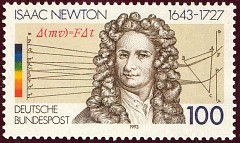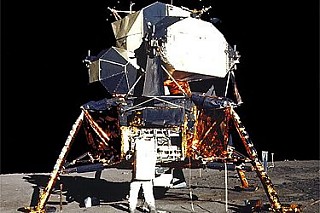 Isaac Newton and the science of motion |
Sir Isaac Newton stated in his Third Law of Motion that "every action is accompanied by an equal and opposite reaction." There are countless examples of this principle that affect you every day. To see it in action, try the following simple experiment. Stand on a pair of roller skates holding a heavy ball (a basketball will do, but a medicine ball is even better). Now throw the ball as hard as you can using a chest pass, and observe what happens. For every action (the ball goes one way) there is an equal and opposite reaction (you go the other).
Notice something very important here. What did the ball push against to make you go backwards? Answer: absolutely nothing. It wasn't the ball pushing on something, it was you pushing against the ball that made you go backwards. It's important to get this straight, since it is a very common misconception that the gases in a rocket have to push against something. In fact, it's exactly the opposite. The rocket is pushing against the gases that it ejects from its motor.
While it is the third law that describes how the rocket will move, it is Newton's second law – force equals mass times acceleration, or F = ma – that describes the size of the push. That's why it was suggested that you use a heavy ball, since it will have more mass. You'll probably throw the ball with approximately the same acceleration each time. However, if the mass is greater, and acceleration the same, then the heavier mass produces more force. This can be shown symbolically, where the size of the letters indicates the size of the numbers, as such:
|
||
The acceleration is the same (20 metres per second squared) for each, but the larger mass of 10 kg, creates a proportionately larger force. Notice that the unit of force is called a Newton, and is equal to the force required to accelerate a 1 kg mass 1 meter per second. |
In a rocket engine we would like to produce the maximum force for the minimum mass of fuel used. This is because we have to accelerate the rocket, so again Newton's second law is at work. The more force we can produce from our rocket engine, the more we can accelerate our rocket. We can produce the maximum force by throwing the mass as fast as possible out the back of our rocket. Then because of the action - reaction principle, our rocket will go as fast as possible in the opposite direction.
That's the science behind a rocket. Of course, the technology is a lot more complex. We have to feed enormous quantities of fuel and an oxidizer into a reaction chamber where they will burn at an extremely high temperature and pressure, and be thrown out the nozzle at supersonic velocities. A rocket engine is not a simple apparatus!
Newton's laws also tell us why we build rockets in stages. When we lift-off, our rocket will be very heavy, because it will need a lot of fuel. A large mass needs a large force to accelerate it, so we are going to have to burn a lot of fuel. A lot of fuel means more mass, and so we have a circular problem. If we make our rocket too big, we'll never get enough fuel into it to get it off the ground (the rocket equation can be used to show how much propellant we need). So we build rockets in stages. The first stage is large, burns a lot of fuel, and doesn't accelerate our rocket to a very high velocity, as it travels through the densest part of the Earth's atmosphere. Then we throw this part of the rocket away (stage separation), and we have a lot less mass to accelerate, and also a lot less drag from atmospheric friction. Thus we need less fuel, and a smaller engine, and it can accelerate to a higher velocity. On the space shuttle, solid rocket booster engines are used for the initial acceleration and separate from the shuttle once it has been accelerated. Then the main fuel tank is also jettisoned as the shuttle nears its orbital velocity. Final acceleration is done with fuel stored in the shuttle orbiter itself.
The efficiency of a motor is called its specific impulse (Isp). It is measured in seconds, since it is equal to the kilograms of thrust the motor generates per kilogram of fuel used per second of operation. The higher the Isp, the more efficient the fuel.
| Propellant | Oxidizer | Isp (s) |
| Liquid Hydrogen (H2) | Liquid Oxygen LOX (O2) | 450 |
| Liquid Methane (CH4) | LOX | 350 |
| Kerosene | LOX | 260 |
| Mono-methyl hydrazine (CH3N2H3) | Nitrogen tetroxide (N2O4) | 310 |
 |
In the Saturn V rocket used to go to the moon ![]()
![]() ,
the first stage burned kerosene and LOX, while the second and third stages used liquid
hydrogen and LOX. At launch, the Apollo-Saturn rocket had a mass of about 3 million
kg. The lunar lander module used hydrazine and nitrogen tetroxide fuels, and had a
mass of about 5000 kg at lift off. This is almost 600 times smaller – an
enormous difference in mass.
,
the first stage burned kerosene and LOX, while the second and third stages used liquid
hydrogen and LOX. At launch, the Apollo-Saturn rocket had a mass of about 3 million
kg. The lunar lander module used hydrazine and nitrogen tetroxide fuels, and had a
mass of about 5000 kg at lift off. This is almost 600 times smaller – an
enormous difference in mass.
Because Mars has much more gravity that the moon, and because we will also want to return from there more quickly (it's a long ways to go!), the ratio of masses between Earth takeoff and landing will be even greater. Thus the need for generating part of the fuel on Mars becomes much more obvious. In fact, with our current, and foreseeable technology, it is probably impossible to build and launch from Earth a rocket big enough to carry all the fuel necessary to return a manned spacecraft from Mars. Therefore, is is almost certain that our mission to Mars will start from a space station. The fuel to launch from the space station will have to be relayed in several trips from Earth. Then on Mars, fuel needed to return to Earth will be generated by chemical reactions in the Martian atmosphere. This way, our journey will be made a lot easier.
| Balance each of the following combustion equations. Put the proper coefficients into each box, then press the [Check] button. |
| For each of the following, calculate the heat of combustion, using Hess's law (these
questions will not be displayed until you have balanced equations 2 and 3). |
| For each of the above reactions, calculate the heat produced per unit of
mass consumed (these questions will not be displayed until you have answered equations 4
and 5). |